Redneck Revolt: the armed leftwing group that wants to stamp out fascism | US news
The cookout offered free food, a face-painting booth and a “protest sign-making station†â€" a pile of cut-up cardboard boxes, paint markers and rolls of packing tape. A group of neighborhood boys, each no older than 12, gathered around. They wanted signs to tape to their bicycles, so they could ride around and “tell Trump†what they thought of him.
One grabbed a piece of cardboard and wrote in big letters: “TRUMP’S A BITCH.â€
Max Neely quickly stepped in.
“I’m not sure you should use that word,†he said, his voice taking on a fatherly tone. At 6ft2in, he towered over them. “That word isn’t very respectful to women, and there are a lot of women around here today that we should be respecting. Maybe you can think of another word to use.â€
The boys conferred. Eventually, they settled on a different, less offensive protest sign â€" at least in Neely’s eyes. “FUCK TRUMP,†it read, followed by four exclamation points.
A 31-year-old activist with long hair and a full bushy beard, Neely had a full day of political activism ahead of him: Donald Trump was in Harrisburg to mark his 100th day in office with a speech at the Pennsylvania Farm Show Complex. In other parts of the city, the liberal opposition were also readying themselves: organizations such as Keystone Progress, Dauphin County Democrats and the local Indivisible group planned to march in protest.
Neely’s group were not among them. Instead, they had set up a picnic site in a small park, offering a barbecue and leftist pamphlets. Someone had planted a bright red hammer-and-sickle flag in the grass. On a nearby table hung a black banner that bore the words “Redneck Revolt: anti-racist, pro-gun, pro-laborâ€.
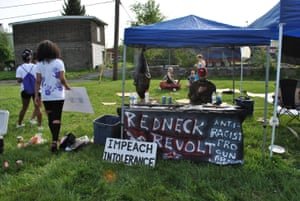
“If you haven’t noticed, we aren’t liberals,†said Jeremy Beck, one of Neely’s cookout friends. “You know, if you keep going further left, eventually, you go left enough to get your guns back.â€
Wooly liberals, they’re not. Redneck Revolt is a nationwide organization of armed political activists from rural, working-class backgrounds who strive to reclaim the term “redneck†and promote active anti-racism. It is not an exclusively white group, though it does take a special interest in the particular travails of the white poor. The organization’s principles are distinctly left-wing: against white supremacy, against capitalism and the nation-state, in support of the marginalized.
Pennsylvania is an open-carry state, where gun owners can legally carry firearms in public without concealment. Redneck Revolt members often see the practice of openly carrying a gun as a political statement: the presence of a visible weapon serves to intimidate opponents and affirm gun rights. Many of the cookout attendees owned guns, and had considered bringing them today â€" but ultimately they had decided to come unarmed, in the interest of keeping the event family-friendly.
Redneck Revolt began in 2009 as an offshoot of the John Brown Gun Club, a firearms training project originally based in Kansas. Dave Strano, one of Redneck Revolt’s founding members, had seized upon what he saw as a contradiction in the Tea Party movement, then in its infancy. Many Tea Party activists were fellow working-class people who had endured significant hardships as a result of the 2008 economic crisis which, in his eyes, had been caused by the very wealthy. And yet, Tea Partiers were now flocking in great numbers to rallies funded by the 1%.
By supporting economically conservative politicians, Strano thought, they would only be further manipulated to benefit the already rich.
“The history of the white working class has been a history of being an exploited people,†he wrote. “However, we’ve been an exploited people that further exploits other exploited people. While we’ve been living in tenements and slums for centuries, we’ve also been used by the rich to attack our neighbors, coworkers, and friends of different colors, religions and nationalities.â€
Now, eight years later, more than 20 Redneck Revolt branches have sprouted across the US; the groups range widely in size, some with only a handful of members. Max Neely is a member of the Mason-Dixon branch, which encompasses central Pennsylvania as well as his native western Maryland. Many members are white, but the organization seeks to build on a “redneck†identity beyond race.
“I grew up playing in the woods, floating coolers of beer down a river, shooting off fireworks, just generally raising hell, all that kind of stuff,†said Neely. “Things most people would consider a part of redneck culture. We’re trying to acknowledge the ways we’ve made mistakes and bought into white supremacy and capitalism, but also give ourselves an environment in which it’s OK to celebrate redneck culture.â€
The group draws a great deal of inspiration from the Young Patriots Organization, a 1960s-era activist group consisting primarily of white working-class Appalachians and southerners. “I’m very impressed with Redneck Revolt,†said Hy Thurman, one of the early founders of the Young Patriots. “I think they’re right on with what they’re trying to do.â€
The group opposed racism and worked closely with the Black Panthers, but they did make use of the Confederate flag in their recruiting. Thurman explained that it was used only strategically, to start conversations with poor white people who might identify with the symbol.
In the same way that the Young Patriots once used the Confederate flag, Redneck Revolt seeks to employ another emblem of rural America: guns.
Redneck Revolt groups work on providing an explicitly anti-racist presence in rural areas, and focus particularly on gun shows. Many members are from places where guns are relatively normalized, and Neely wants Redneck Revolt to serve as a viable alternative for people who might otherwise join the growing right-wing militia movement.
Since the 1992 Ruby Ridge siege, the US has witnessed an increase in anti-government paramilitary organizations. Oath Keepers, for example, is a militia group that strives to defend the US constitution, which the group believes is under threat by its own government. They claim to be nonpartisan, but its members’ politics tend to skew far right. During last year’s presidential election, they announced that members would be monitoring voting booths to prevent election tampering, stating he was “most concerned about expected attempts at voter fraud by leftistsâ€.
But groups like Oath Keepers have much in common with far leftists: concerns about the infringement of human rights, objections to mass surveillance and the ever reauthorized Patriot Act, anger at the continued struggles of the working poor.
“We use gun culture as a way to relate to people,†said Neely, whose grandfather was an avid hunter. “No liberal elitism. Our basic message is: guns are fine, but racism is not.â€
Officially, Oath Keepers’ bylaws prohibit anyone associated with a hate group from joining, though their background checks have proven to be inconsistent at best. But there are other rightwing groups around â€" the explicitly racist kind.
“I’m worried about Pikeville,†said Neely. “I’ve got friends out there.â€
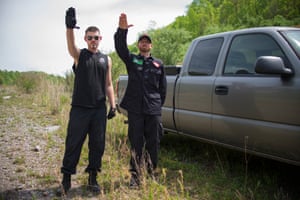
Pikeville is a small Kentucky town deep in the heart of Appalachia. It has no major airport or interstate, a population of less than 10,000 and an abundance of idyllic mountain scenery. Mining has long been the major industry here, though Pikeville also attracts tourism: mid-April draws over 100,000 visitors to the annual Hillbilly Days festival, a celebration of Appalachian culture and music.
In the week after the festival ended, however, Pikeville’s atmosphere had taken a distinct turn. Neo-Nazis were coming to town the same day as Trump’s appearance in Harrisburg.
The Nationalist Front â€" an alliance of far-right white nationalist organizations â€" was planning a rally in front of Pikeville’s courthouse. “Take a stand for white working families,†read an invitation that circulated online.
“This begins a process of building and expanding our roots within white working class communities to become the community advocates that our people need and deserve,†wrote Matthew Heimbach on the Daily Stormer, a neo-Nazi website.
Pike County â€" chronically impoverished, overwhelmingly white â€" is seen as a fertile setting for spreading their ideology. The city of Pikeville itself has actually experienced some growth in the past few years, but the greater area is struggling. Pike County’s unemployment rate is one of the highest in the nation: 10%, more than twice that of the US as a whole.
Trump successfully tapped into this desperation with his pro-labor, anti-immigrant rhetoric and successfully won more than 80% of votes cast. Citing this figure, Heimbach hoped to develop existing pro-Trump sentiments into full-blown national socialism.
“We’re doing this because we care about the people of Pike County,†said Jeff Schoep, head of the neo-Nazi National Socialist Movement, in a video promoting the rally. “We’ve seen factories shut down, we’ve seen people losing their jobs, we’ve seen families getting desperate and reaching out for drugs or other things that they shouldn’t be doing. We want to give people hope again. Something worth fighting for.â€
That something happened to be a white ethno-state, and many Pikeville residents were not interested.
The city approved a permit for the Nationalist Front to gather downtown, citing the constitutional right of free speech and assembly, though Donovan Blackburn, the city manager, also issued a statement promoting peace, respect and diversity.
Students at the University of Pikeville planned a counter-protest, but the event was quickly canceled due to safety concerns: university officials feared that a conflict between the Nationalist Front and members of the antifascist movement â€" or antifa â€" could escalate into violence.
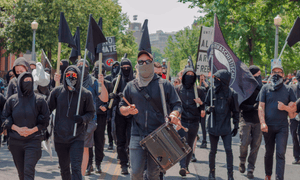
Developed in Europe over the past few decades, antifascists represent the left’s own united front: a conflux of anarchists, communists, social democrats and others, dedicated to stamping out fascism by any means necessary, including violence â€"which they see as a justified response to the inherent violence of fascism. They often employ “black bloc†tactics, where individuals wear masks and all-black clothing to avoid police identification.
Antifascist groups have never been as prominent in the US as they have been in countries such as Greece, where masked individuals recently smashed the windows of the Golden Dawn’s headquarters. But in the wake of Trump’s election and the ensuing spate of hate crimes, they have swiftly mobilized. A masked man famously punched white nationalist Richard Spencer in Washington DC on Inauguration Day; two weeks later, antifascists lit fires on UC Berkeley’s campus in protest of rightwing ideologue Milo Yiannopoulos.
“We live in a historical moment where there’s unprecedented wealth inequality, and the average person is struggling to get by,†said Sidney (not his real name), an Appalachian antifascist who has been keeping a close watch on white nationalist activity in his area. “When governments, as they characteristically do, fail to step in, people look to other institutions for an answer. Fascism is having a resurgence because we’re in that moment. It’s not a problem that’s going to be solved by leaving it alone. That’s like leaving an infection alone.â€
A 27-year-old native of West Virginia, Sidney comes from a coal mining family. He splits his time between installing drywall and organizing with Redneck Revolt.
“Pikeville really caught my attention,†said Sidney. “The Traditionalist Worker party’s been making real efforts to organize in Appalachia. I’m not a Kentuckian, but I’m a working-class Appalachian, and it really sticks in my craw.â€
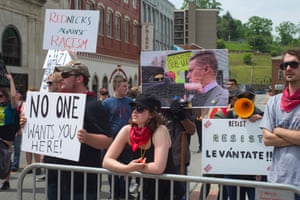
To dissuade antifascists, who often wear masks during demonstrations, the Pikeville city commission passed an emergency ordinance that prohibited the wearing of masks or hoods in downtown Pikeville. Anyone above the age of 16 wearing a mask or hood would be subject to 50 days in jail and a $250 fine.
Antifascist demonstrators would have to show their faces, which could be potentially dangerous: neo-Nazi groups have been known to use facial recognition software and other tactics to identify counter-protesters, acquire personal information and subject those identified to further harassment.
“At Redneck Revolt, we tend not to cover our faces anyway,†said Sidney. “We want to make inroads with the community, and it’s easier if they knew who you are.â€
But Sidney had a greater concern: Kentucky is another open-carry state and Heimbach had encouraged members of the Nationalist Front to come armed, ahead of “possible leftist attacksâ€. At least, however, he would have his own firearm: his Smith and Wesson semi-automatic pistol, which he decided to carry concealed.
A couple locals had expressed to Sidney that they wished they would all go home â€" both neo-Nazis and antifascists.
“I can’t blame them for feeling like that,†said Sidney. “They’ve got this huge ideological fight on their doorstep that they didn’t ask for.â€
Regardless, some time after noon, a large group of antifascist protesters â€" some armed, some wearing bulletproof vests â€" headed to the courthouse, ready to face the Nationalist Front.
Instead, they saw only about 10 white nationalists, waiting in a little area that had been fenced off by police. They were members of the League of the South, a group that promotes a renewed attempt at secession from the US. The two major Nationalist Front delegations, the Traditionalist Workers party and the National Socialist Movement, were missing.
Rumor soon spread that they were lost.
“Given that they’re not from this region, and they don’t represent the people here, it’s not terribly surprising,†said Sidney.
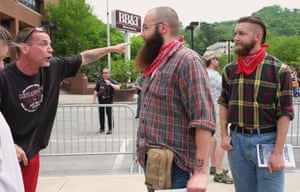
Back in Harrisburg, a group of six young white nationalist men wearing a uniform of white polo shirts approached Neely’s cookout site; they looked like missionaries, clean-shaven with neatly combed hair.
Max Neely approached them and asked, cautiously, whether they were interested in socialism.
No, they responded. They identified themselves as members of Identity Evropa, a white nationalist group that endorses racial segregation and only admits applicants of “European, non-Semitic heritageâ€. They had initially supported Trump as a presidential candidate, but were now in Harrisburg to protest him; they were disappointed that he had not yet created a white ethno-state.
Neely wanted to keep them away from the cookout. On another day, in a different setting, some of his associates might have come ready for a fight. But today was meant to be family-friendly, and many of the picnic attendees were young black activists from a local high school. They could handle themselves, Neely knew, but the task of arguing for the legitimacy of your existence against those who deny your humanity is an arduous one.
So while his Redneck Revolt friends kept a careful watch from across the street, Neely let the Identity Evropa members talk more about their ideology â€" about how the US was a nation meant for white people, how white culture was under attack. Neely debated them as politely as he could, hoping his quiet listening could diffuse the situation. They thanked him for being so calm and civil.
“It’s easy to be calm when you’re a white man,†said Neely. “It’s easy when it’s not your life or your family’s lives at stake.â€
They could not see the back of his shirt, which depicted a hooded figure dangling from a tree, and the words HANG YOUR LOCAL KLANSMAN.
The encounter ended rather decisively: three local teenage girls had chased off the white nationalists.
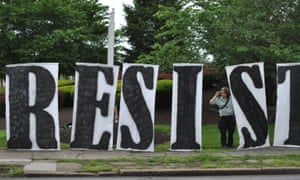
By mid-afternoon, the cookout was in full swing. Nearby residents filled plates with barbecued chicken and strawberries. A neighborhood man looked at the pamphlets that Neely had laid out. “Piece Now, Peace Later: An Anarchist Introduction to Firearmsâ€, read one title.
“Y’all trying to overthrow the government?†he asked.
“It’s more about community defense,†answered Travis, one of the Redneck Revolt members.
“I just wanted to warn you,†the man continued. “West Philadelphia, 1985. Look what happened to them.â€
He was talking about the left’s own Ruby Ridge moment: in May 1985, a Philadelphia police helicopter dropped a bomb on to the row house that had served as a headquarters for Move, an armed black liberation group. There were 11 casualties, including the group’s founder, John Africa, as well as five children. The resulting fire destroyed 65 houses. A special commission later appointed by the mayor to investigate the incident concluded that the bombing had been “unconscionableâ€.
When Neely and other white members of Redneck Revolt claim allyship with movements like Black Lives Matter, they are compelled to acknowledge their whiteness â€" in particular, their ability to carry weapons with impunity.
When Oath Keepers began to patrol rooftops during the 2014 protests in Ferguson, Missouri, their intention was to protect protesters from the police â€" but many activists were alarmed and intimidated by the appearance of heavily armed white men. When Redneck Revolt members show up at black-led protest events, they are generally invited.
“They are our security,†said Katherine Lugaro, an organizer with This Stops Today, Harrisburg’s local iteration of Black Lives Matter. “They’re a wall between us and anyone hateful. They put themselves on the line.â€
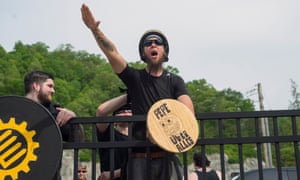
Back in Pikeville, a full hour after the rally was scheduled to begin, a caravan rolled into the parking lot down the street. Matthew Heimbach and the rest of the neo-Nazis had arrived. Close to 100 people, dressed in head-to-toe black and carrying Nazi insignia, marched up to the courthouse building. Many in the front were visibly armed; others carried wooden shields decorated with swastikas and Norse runes. Someone had brought a shield featuring Pepe the Frog and the words “Pepe Ãœber Allesâ€. They sieg-heiled to Heimbach.
They were outnumbered by protesters two-to-one.
Then came a few hours of scheduled neo-Nazi speeches. This turned into a few hours of shouting, as the antifascists attempted to drown out the sound system with drums and jeers. “From the midwest to the south,†they chanted, “punch a Nazi in the mouth.â€
A handful of Pikeville residents lingered on the other side of the police barricade, listening to the Nationalist Front speeches. But most locals present had trickled in along with the protesters, eventually making up a third of the crowd, and had joined in with the jeering.
“They were absolutely the most strident antifascist voices there,†said Sidney. “I’m assuming most of these folks were apolitical, or maybe conservative, but they were drawing a line in the sand.â€
No injuries, no shots fired; the Nationalist Front finished their speeches and returned to their caravan. A heavy police presence had kept the two groups separated and prevented any opportunity for confrontation. It was over.

In Harrisburg, night fell. Max Neely and his band of companions eventually regrouped at a local bar. They drank beers and talked about hockey. After a while, they gathered in a private side room to debrief.
They sat around an ashtray and chain-smoked cigarettes and carefully took turns recalling the events of the day. Late in the evening, Keystone Progress had led a protest march down the street near the cookout, though after police refused to let them pass through a blocked area the march fizzled.
“Liberals,†Chris Siennick muttered. A general disdain for liberals is, perhaps, the most notable commonality between the far left and far right.
But there were other items on the agenda. A Trump protester had been arrested earlier in the day, accused of having an altercation with a police horse; the group wanted to provide jail support. There was an immigration rights event in two days. And what did they want to do for the Central Pennsylvania pride festival?
Incidentally, the room was draped with American flags.

0 Response to "Redneck Revolt: the armed leftwing group that wants to stamp out fascism | US news"
Posting Komentar